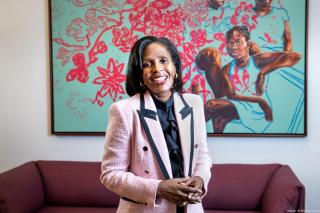This Saturday is Women’s Equality Day, which commemorates the 1920 adoption of the Nineteenth Amendment to the U.S. Constitution that prohibits the states and federal government from denying the right to vote on the basis of sex. This year’s theme of #EmbraceEquity is especially timely, and it reminds me of the power of women’s centered colleges to not only embrace equity, but to advance it.
Across the world, women and non-binary people have yet to achieve equal rights and equal representation. A 2023 report by UN Women and the United Nations Development Programme found that less than 1 percent of women and girls live in countries with high women’s empowerment and a small gender gap.
Despite some gains in the U.S., challenges persist, from the rollback of reproductive healthcare to a gender pay gap that has largely remained stagnant over the past 20 years. For example, more than twice the number of Americans are dying of pregnancy-related causes compared to two decades ago, according to a paper recently published in JAMA. On the economic side, women earned 80 percent as much as men in 2002. As of 2022, that number improved to just 82 percent, according to the Pew Research Center.
Women’s-centered institutions of higher education are uniquely suited to address many of these persistent inequities because of their history, mission, and commitment to social justice. Simmons was founded for equality 125 years ago with the idea that women, through education, could achieve greater financial security and independence. This idea – using education to advance social and economic equity – is the core DNA of this institution. And it remains at the heart of who we are today.
The facts support this. Graduates of women’s centered colleges like Simmons on average hold higher positions in their careers, increase their earning power, and find more satisfaction in their work. At the same time, they are more likely to express the goal of wanting to influence our political structures, and to have worked on a local, state, or national campaign. During their time at school, they report higher levels of class participation, faculty interaction, and are more likely to participate in faculty-led research projects.
All of this means that students like ours graduate confident, well-prepared, and poised to not only succeed, but lead in critical fields such as the health and library sciences, management, and communications. In my travels this summer speaking to Simmons alums across the country, I have seen this leadership firsthand. Our graduates are nurses, social workers, librarians, writers, scientists, journalists, CEOs, and more. These individuals continue to leverage their education to infuse vibrancy and leadership into their institutions and communities.
Unfortunately, women’s colleges are becoming an increasingly endangered species at a time when they are needed more than ever. In the 1960s, there were over 200 women’s colleges in the United States. Today, about 30 remain. In this rapidly changing, hyper-competitive, post-COVID higher education environment, Simmons has been proactive in developing a vision for the future – one that is laser-focused on accelerating student pathways to meaningful careers and developing students with the leadership skills to create a more just world. This vision and plan will allow us to not only survive, but thrive, far into the future.
At the same time, we must ensure our leaders have a deeper understanding of who women’s-centered colleges really are today. These vibrant and diverse institutions are doing critical work serving under-represented populations of lower-income, first-generation, and LGBTQ+ students. And we need the support of a strong and committed mega community to advance education equity for these groups. This includes the involvement of local, state, and federal government; the corporate sector; and nonprofit organizations and foundations. We also need to more effectively blur the line between K-12, higher education, and post-graduate education, as each step is important to millions of students across the U.S.
As we celebrate Women’s Equality Day, I hope we will recognize those that are working to make a difference for women and girls around around the world, including the women’s-centered institutions that are advancing equity each and every day.

